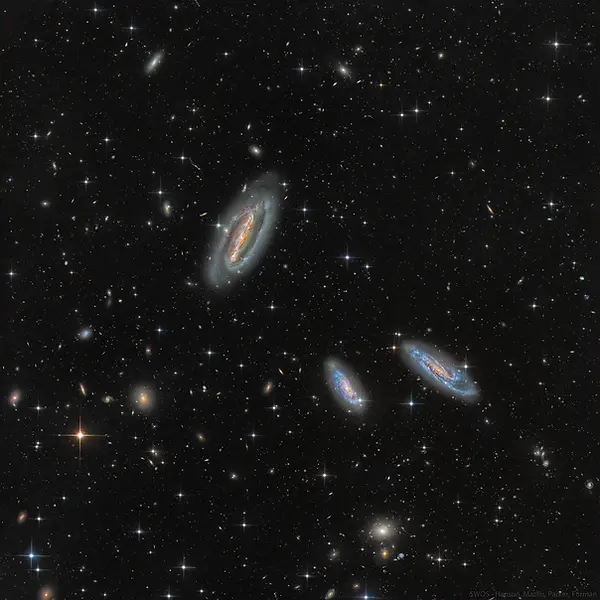

Masters of PixInsight + SWOS
World-Class Imaging Data, Now Available to Our Subscribers
Masters of PixInsight is proud to partner with SWOS (Stan Watson Observatory South) to bring our subscribers access to some of the finest deep-sky imaging data in the world.
About SWOS
Located under the pristine skies of the Chilean Andes, SWOS is equipped with a PlaneWave 24” CDK telescope mounted on a PlaneWave L-600 direct drive mount, paired with a Moravian C5 camera. At 2x2 binning, the system delivers an extraordinary 0.39 arcseconds per pixel, making it possible to capture the finest details of galaxies, nebulae, and star clusters in the southern hemisphere. In addition to Chilean data, we're also offering data sets from the old SWOS observatory in New Mexico. Data was acquired with a 24” PlaneWave, PlaneWave A200HD mount, SBIG 16803; 17” PlaneWave, PlaneWave A200HD mount, and SBIG 16803.
This observatory is managed by award-winning astrophotographer, Mark Hanson (hansonastronomy.com), known worldwide for his dedication to quality and his stunning astrophotography portfolio.
SWOS - Chile
NGC7582, 7590, 7599 Grus Trio

The Grus Trio of galaxies is in the Constellation of Grus, some 60 million light-years from Earth. The group is often referred to as The Grus Quartet, but NGC 7552 is out of this field of view. This galaxy triplet lies in the southern constellation of Grus and the three spiral galaxies (NGC 7582, 7590, 7599) exhibit telltale signs of gravitational interactions.
NGC 6357 War and Peace

Also called the Lobster Nebula, it houses the open star cluster Pismis 24 near its center–a home to unusually bright and massive stars. The overall blue glow near the inner star-forming region results from the emission of ionized hydrogen gas.
Cat's Paw–NGC 6334

At 5,500 light-years distance, the Cat's Paw is an emission nebula with a reddish color that originates from an abundance of ionized hydrogen atoms. Alternatively known as the Bear Claw Nebula, stars nearly ten times the mass of our Sun have been born there in only the past few million years.
NGC 1313

Usually, galaxies this topsy-turvy result from a recent collision with a neighboring galaxy. Spiral galaxy NGC 1313, however, appears to stand alone. Brightly lit with massive, new blue stars, star formation appears so rampant that it has been labeled a 'starburst galaxy.'
M17

Messier 17, or as it’s more famously known, the Omega Nebula (or Swan Nebula), is considered one of the brightest and most massive star-forming regions in our galaxy. Sculpted by stellar winds and radiation, this stellar nursery is 5,500 light-years away in the Sagittarius constellation.
NGC 247 Needle’s Eye Galaxy

NGC 247 is a spiral galaxy smaller than our Milky Way, and is measured to be only 11 million light-years distant. Tilted nearly edge-on from our perspective, it dominates this telescopic field of view toward the southern constellation, Cetus. The pronounced dark void on the bottom side of the galaxy's disk recalls for some, its popular name, the Needle's Eye galaxy.
SWOS - New Mexico
IC 1871

Zooming in on the northeastern part of the Soul Nebula, this image shows a few groups of bright rimmed globules that are catalogued as IC 1871 (left) and SFO 12 (right). Their gaseous forms are sculpted by UV radiation and stellar winds from hot, young stars in the star cluster associated with the Soul Nebula.
NGC 5566

Along with NGC 5560 and 5569, NGC 5566 forms a trio of interacting galaxies almost 90 million light-years away, toward the constellation Virgo. On the left, two, spiky, foreground Milky Way stars echo the trio of galaxy's hues, a reminder that stars in our own galaxy are like those in these distant island universes.
NGC 6960

The Witch’s Broom is part of the expansive Veil Nebula supernova remnant in Cygnus. The imaging data provided here are masters from a carefully merged mosaic, ensuring seamless coverage of this sprawling target, while preserving the finest details across the field.







